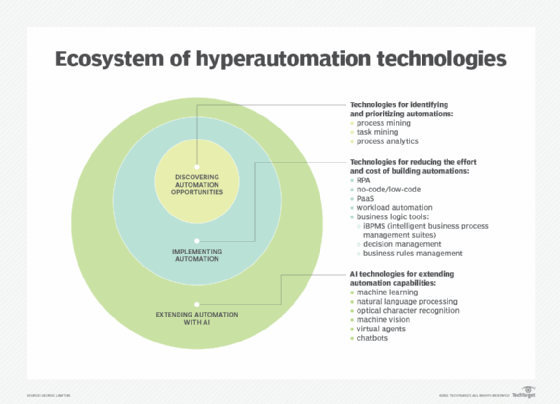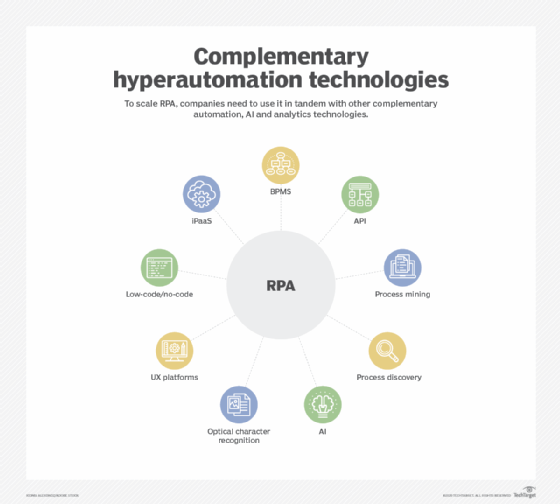
hyperautomation
What is hyperautomation?
Hyperautomation is a framework and set of advanced technologies for scaling automation in the enterprise. The ultimate goal of hyperautomation is to develop a process for automating enterprise automation.
Advanced technologies used in hyperautomation include the following:
- process mining and task mining tools for identifying and prioritizing automation opportunities.
- Automation development tools for reducing the effort and cost of building automations. They include robotic process automation (RPA), no-code/low-code development tools, integration platform as a service (iPaaS) for integrations, and workload automation tools.
- Business logic tools for making it easier to adapt and reuse automations, including intelligent business process management (BPM), decision management and business rules management.
- Artificial intelligence (AI) and machine learning algorithms and tools for extending the capabilities of automations. The range of tools in this area includes natural language processing (NLP), optical character recognition, machine and computer vision, virtual agents and chatbots.
The term hyperautomation was coined in 2019 by the IT research firm Gartner. The concept reflects the insight that RPA technology, a relatively new and massively popular approach to automating computer-based processes, is challenging to scale at the enterprise level and limited in the types of automation it can achieve. Hyperautomation provides a framework for the strategic deployment of various automation technologies, separately or in tandem, augmented by AI and machine learning.
Hyperautomation implies a studied approach to automation. A hyperautomation practice involves the following steps:
- Identifying what work to automate.
- Choosing the appropriate automation tools.
- Driving agility through the reuse of automated processes.
- Extending their capabilities using various types of AI and machine learning.
Hyperautomation initiatives are often coordinated through a center of excellence (CoE) that helps drive automation efforts.
The benefits of hyperautomation include cost savings, as well as boosting productivity and efficiencies. It also helps organizations capitalize on data generated and collected from digitized processes. Organizations can plumb that data to improve their decision-making.

Why is hyperautomation important?
Hyperautomation provides organizations with a framework for expanding on, integrating and optimizing enterprise automation. It builds on the success of RPA tools and addresses their limitations.
This article is part of
Ultimate guide to RPA (robotic process automation)
RPA owes its rapid growth, relative to other automation technologies, to its ease of use and intuitive nature. For example, because RPA mirrors how people interact with applications, employees can automate one part or all of their work by recording procedures for RPA systems to follow. Companies can use the same metrics that they use to evaluate human employee performance -- speed and accuracy, for instance -- to measure RPA success.
Early RPA efforts didn't scale easily. Initially, only about 13% of enterprises were able to scale early RPA initiatives, according to a 2019 Gartner assessment. In 2022, Deloitte's Global Outsourcing Survey found that 66% of enterprises were using RPA in some capacity, but only 34% of those used it across the entire organization. Hyperautomation forces enterprises to think about the types and maturity of the technologies and processes required to scale automation initiatives.
In Gartner's view of hyperautomation, the focus is on how enterprises can build a process for automating the automations. This separates hyperautomation from both other automation frameworks that simply focus on improving automation tools and automation concepts -- such as digital process automation (DPA), intelligent process automation (IPA) and cognitive automation -- which focus on automation itself.
Hyperautomation takes a step back to consider how to accelerate the process of identifying automation opportunities. It then automatically generates the appropriate automation artifacts, including bots, scripts or workflows that might use DPA, IPA or cognitive automation components.
A complementary idea to hyperautomation is what Forrester Research calls digital worker analytics. This approach also focuses on performance and process, such as how to track the cost of developing, deploying and managing automations to compare the cost to the value delivered. This analysis is important for prioritizing future automation efforts. Most RPA and enterprise automation vendors are starting to introduce digital worker analytics into their tools.
How does hyperautomation work?
Rather than referring to one single, out-of-the-box technology or tool, hyperautomation centers on adding more intelligence and applying a broader systems-based approach to scaling automation efforts. The approach underscores the importance of striking the right balance between replacing manual efforts with automation and optimizing complex processes to eliminate steps.
A key question lies in identifying who should be responsible for the automation and how it should be done. Frontline workers are in a better position to identify time-consuming, repetitive tasks that could be automated. Business process experts are in a better position to identify automation opportunities that are handled by many people.
Gartner has introduced the idea of a digital twin of the organization (DTO). This is a virtual representation of how business processes work. The representation of the process is automatically created and updated using a combination of process mining and task mining. Process mining analyzes enterprise software logs from business management software such as customer relationship management (CRM) and enterprise resource planning (ERP) systems to construct a representation of process flows. Task mining uses machine vision software running on each user's desktop to construct a view of processes that span multiple applications.
Process mining and task mining tools can automatically generate a DTO, which enables organizations to visualize how functions, processes and key performance indicators interact to drive value. The DTO can help organizations assess how new automations drive value, enable new opportunities or create new bottlenecks that must be addressed.
AI and machine learning components enable automations to interact with the world in more ways. For example, optical character recognition (OCR) allows automation to process text or numbers from paper or PDF documents. Natural language processing can extract and organize information from documents, such as identifying which company an invoice is from and what it's for, as well as automatically capturing the data into the accounting system.
A hyperautomation platform can sit directly on top of the technologies companies already have. RPA is one way to implement hyperautomation. All the leading RPA vendors are adding support for process mining, digital worker analytics and AI integration.
Other types of low-code automation platforms, including business process management software (BPMS), intelligent BPMS, iPaaS and low-code development tools, are also adding support for hyperautomation technology components.

Hyperautomation vs. automation
Traditional approaches to enterprise automation focused on the best way to implement automation within a particular context. These automations were highly specific to a particular piece of software. For example, workload automation uses scripts to automate many highly repetitive processes. can automate tasks within the context of a specific workflow.
AI extends traditional automation to take on more tasks, such as using OCR to read documents, natural language processing to understand them and natural language generation to provide summaries to humans. Hyperautomation makes it easier to infuse AI and machine learning capabilities into automations using pre-built modules delivered via an app store or enterprise repository.
Low-code development tools reduce the expertise required to create automations. Hyperautomation could streamline the development of automation even more using process mining to identify and automatically generate new automation prototypes. Today, these automatically generated templates need to be further enhanced by humans to improve quality. However, improvements in hyperautomation will reduce this manual effort.
What are the benefits of hyperautomation?
The top benefits of hyperautomation include the following:
- Lower cost of automation.
- Improved alignment between IT and business departments.
- Reduced need for shadow IT, which improves security and governance.
- Increased adoption of AI and machine learning into business processes.
- Improved ability to measure the impact of digital transformation efforts.
- Help prioritizing future automation efforts.
As enterprises master hyperautomation, there are many ways this discipline could be used to improve business operations and business outcomes.
In the areas of social media, customer retention and customer experience, a company could use RPA and machine learning to produce reports and pull data from social platforms to determine customer sentiment. It could then develop a process for making that information readily available to the marketing team, which could then create real-time, targeted customer campaigns.
If an enterprise launches a product quickly and DPA metrics show strong customer demand for it, the product could be rapidly scaled to help the company grow its revenue. Conversely, if advanced analysis shows that the product fails to gain traction among customers, the company could minimize losses by dropping it fast.
What are the challenges of hyperautomation?
Hyperautomation is a new concept and enterprises are in the early stages of figuring out how to make it work in practice. Some of the biggest challenges include the following:
- Choosing a CoE strategy for the organization. Some organizations might do better with a more centralized approach, while others will see better results with a federated or distributed approach to managing large-scale initiatives.
- Tools. There is no silver-bullet hyperautomation software. Although leading automation vendors are expanding their hyperautomation capabilities, enterprises will struggle to ensure interoperability and integration across these tools.
- Security and governance. Hyperautomation initiatives can all benefit from in-depth monitoring and analysis of business processes that span multiple departments, services, and even country boundaries. This can add a host of new security and privacy issues. In addition, enterprises need to develop the appropriate guardrails for vetting the security vulnerabilities of automatically generated apps.
- Immature metrics. The tools for assessing the cost and potential value of automations are still in their infancy.
- Manual augmentation required. A lot of manual effort is still required and needs to be budgeted when building robust automations at scale.
- Getting human buy-in. Most automation vendors are pushing the narrative that hyperautomation will augment rather than replace humans, but the reality is that automation affects certain jobs once done by humans. Workers need to be convinced that robots will not take their jobs for these efforts to take off. Also, the various monitoring tools used in hyperautomation projects might prompt a backlash from knowledge workers worried about the potential misuse of that data.
Hyperautomation examples and use cases
A hyperautomation initiative typically starts with a specific goal to improve a metric or process. Here are two examples of use cases and how each would proceed.
Financial services
In the first use case, a financial services team might have the goal of processing invoices faster, with less human intervention and overhead, and fewer mistakes. A project could start by using task mining software to watch how human accountants receive invoices, what data they capture and what fields they paste into other apps. This could serve as a template for generating a basic bot.
This template might then be passed over to the automation CoE team who would be tasked with generating a final bot. This could include integrating an OCR engine to improve the ability to read invoices and an NLP engine to interpret the payee or the terms in the invoice. The CoE team would also oversee quality monitoring initially, followed by an assessment of how much it cost to build the bot and how much it saved. This data could help prioritize other automation opportunities.
Order fulfillment
Another use case might involve using process mining software to identify ways to reduce order fulfillment times. This would start by analyzing ERP and CRM data logs to identify why some orders are fulfilled in four hours, while others take four days owing to various exceptions.
Process analytics might identify ways of changing the process that would reduce these delays, such as adjusting credit check requirements for established customers. It might also identify ways to automate manual processes that cause delays in other orders. Once these automations are implemented, the CoE team could calculate the total cost of implementing these improvements and track the total savings over time.
Hyperautomation vendors
No vendors offer all-purpose, end-to-end hyperautomation technology products. However, various automation vendors are expanding their portfolio tools to support a wider breadth of hyperautomation capabilities and strategic technology trends.
Some of the vendors expanding their automation repertoires include the following:
- ABBYY, a leading OCR vendor, has expanded its portfolio of tools to support a variety of intelligent business process automation capabilities. It offers various process mining capabilities through platforms such as ABBYY Timeline.
- Automation Anywhere developed process mining and task mining capabilities for automatically generating bots.
- In 2020, process mining vendor Celonis bought Czech startup Integromat to expand its automation capabilities.
- IBM acquired process mining company MyInvenio in 2021 to integrate process mining capabilities into its automation tools.
- Microsoft has been expanding its hyperautomation capabilities with its Power Automate line of RPA tools and Process Advisor tool for process mining.
- Nintex acquired Kryon in 2022, one of the first intelligent automation tool vendors to incorporate process discovery into its tools.
- Financial services software provider SS&C acquired Blue Prism in 2022, for its process mining capabilities that were developed in a partnership with Celonis.
- UiPath initially bought Process Gold and StepShot in 2019 to build up its process mining capabilities. It then acquired API integration platform Cloud Elements in 2021 and Re:infer a year later for its NLP and text mining capabilities, renaming it UiPath Communications Mining. The goal was to enhance its RPA offerings with AI and API capabilities.
Along with technologies such as mobile platforms, cloud computing and machine learning, hyperautomation is one of several components of a comprehensive digital transformation effort. Find out how CIOs and other IT leaders are driving this digitization approach within their organizations.






